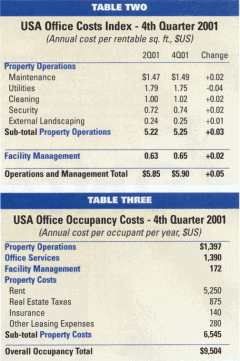Welcome to the 4th Quarter 2001 Johnson Controls USA Office Occupancy Costs Index, which provides a snapshot guide to the cost of providing and operating property and facility management services in the USA. This cost index briefing is published twice a year and has become a powerful and dynamic business reference point for property and facility management professionals. Why Are These Indices Important?
With property and facility management budgets often being squeezed and pressure increasing on managers to demonstrate greater effectiveness and provide more value, understanding how the costs of your operation are changing, and how they compare with others, is vital to identify particular areas of concern. The Johnson Controls USA Office Occupancy Costs Index gives you clear and concise benchmark costs for key property operations and office services activities. This can help as a broad guide and starting point to determine how your organization compares, and where cost levels may be changing through market pressures. We would stress, however, that the unique nature of facilities and individual service requirements means that any comparisons at this level should be undertaken with care. |

The Johnson Controls USA Office Occupancy Costs Index is based on a detailed model of a medium grade air-conditioned office building, which operates reasonably efficiently with no unusually high service standards or demands. The building is 160,000 rentable square feet in size, and houses 600 occupants working between 8am and 6pm 5 days a week. Figures reported reflect changes from the 2nd Quarter 2001 to the 4th Quarter 2001. It does not analyze changes in the cost of rents, local taxes, service charges, insurance, depreciation, small project works, IT and any capital investments/purchases, as variations in the level of these costs are too case specific to monitor in this way. Notional sums for some of these property costs have been added in a separate analysis, however, to give a representation of the total occupancy cost for the model facility.
Costs have been measured in terms of the cost per occupant per year for all services (Table One), and in addition in  terms of cost per rentable square feet (Table Two) for those services where a buildings area can be a significant cost driver. The cost per occupant measure is considered to be the more meaningful of the two from a business perspective, as for all services it is that which is most closely aligned to the primary purpose of the facility from the users perspective i.e. the productive support of people. Table Three shows, on a cost per occupant basis, a notional calculation of the total occupancy cost.
terms of cost per rentable square feet (Table Two) for those services where a buildings area can be a significant cost driver. The cost per occupant measure is considered to be the more meaningful of the two from a business perspective, as for all services it is that which is most closely aligned to the primary purpose of the facility from the users perspective i.e. the productive support of people. Table Three shows, on a cost per occupant basis, a notional calculation of the total occupancy cost.
The Index (Table One) shows that, in overall terms, it now typically costs $2,959 each year to service an office-based employee at a place of work. In terms of the model facility with 600 occupants, this equates to a total annual cost of $1,775,400. Over the 6-month period since the last index this has increased by $14,400. Adding in the property costs gives a total occupancy cost (Table Three) of $9,504 per occupant, which equates to a total annual cost of $5,702,400 for the model facility.

• Maintenance: costs for labor increased approximately 2% while material costs decreased by 1% during this six month period.
• Energy & Water: electricity costs have increased by only 1% this period. Gas prices decreased by 29%. Since electricity is the most significant cost component, the weighted index resulted in only a 1% decrease in cost.
• Cleaning: labor costs have increased by almost 2% during this six month period, while material increased by only 1/2%.
• Security: labor costs have risen by slightly less than 2% .
• External Landscaping: equipment costs declined by about 1/2%. Together with labor cost, the overall increase is approximately 1.5%.
• Internal Moves: labor costs both for operations and management continue to rise, both increasing by just about 2% over the period. This rate of increase is less than last period, where increases were slightly over 3%.
• Reprographics: equipment costs increased by about 1% while paper cost decreased by a drastic 3.4%.
• Mail Room: recent increase in postage combined with 2% labor cost increase has resulted in an overall cost increase of about 2.5%.
• Stationery: The drastic reduction in paper prices have caused a 3.4% decrease in costs during this six month period.
• Food Services: labor and food costs have risen resulting in an increase of about 1.8% compared to prior periods’ increase of 2.5%.
• Facility Management: The rise in management labor cost has slowed to 2% during the last six months compared to 4% during the first half of the year.
Trend
Chart 4 shows how the Johnson Controls Office Costs Index has represented the changing level of underlying facility costs over the last 3 years. Both PPI and CPI dropped during the last six months while the Office Cost Index rose. Falling energy prices were the primary contributors to the decrease in PPI and CPI. The Office Cost Index rose reflecting the on-going increase in the cost of labor, which is the major cost component for facility management companies.

